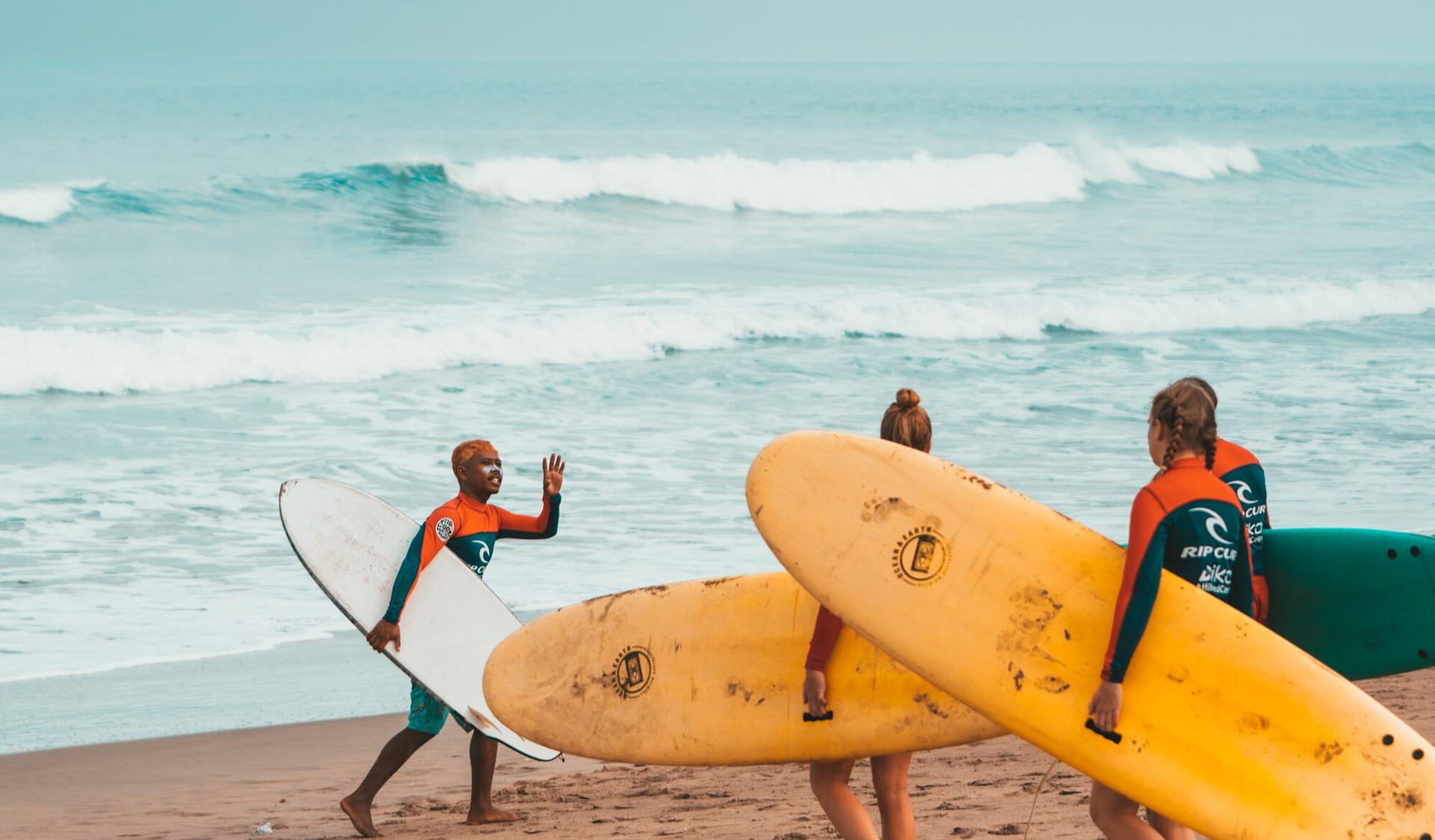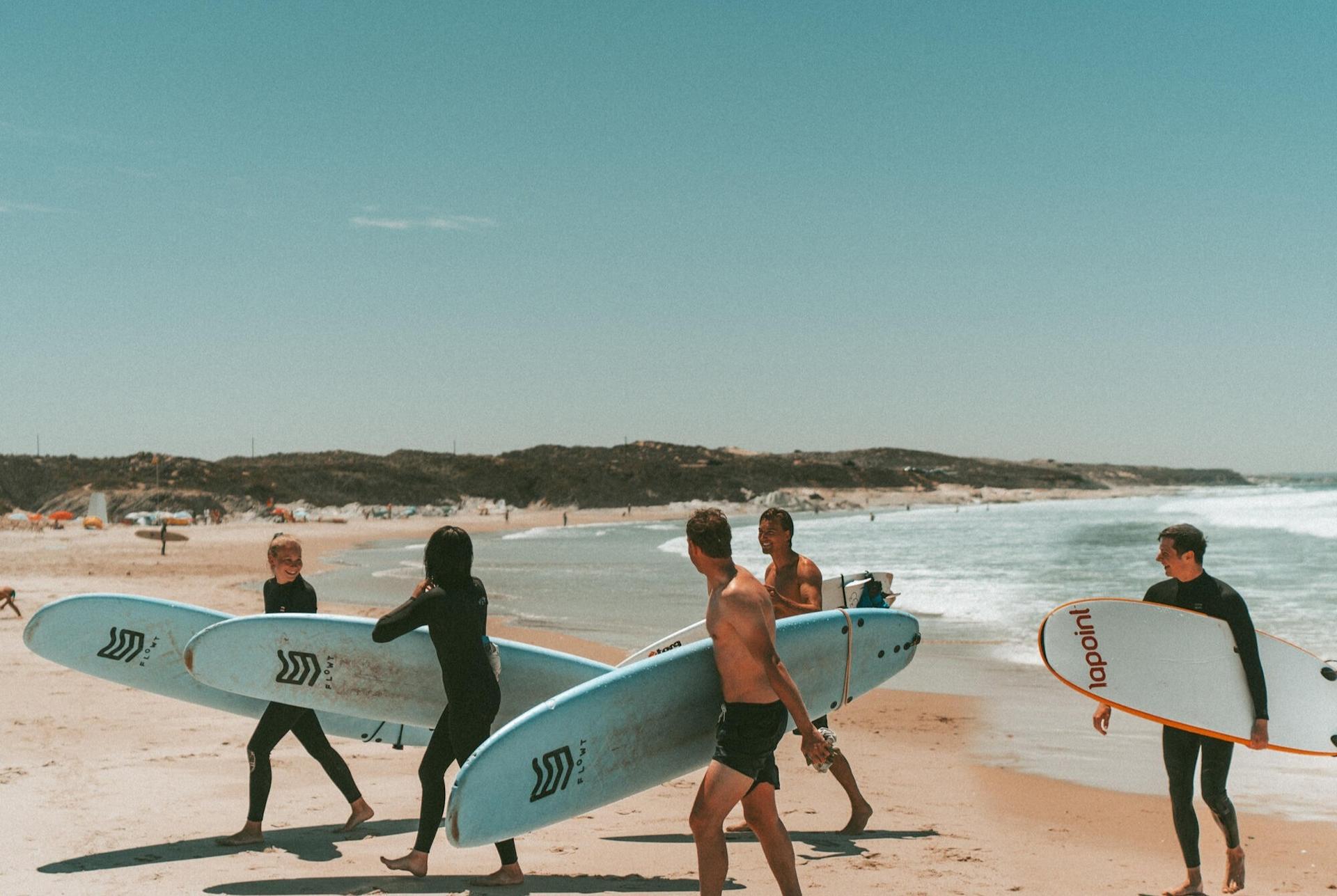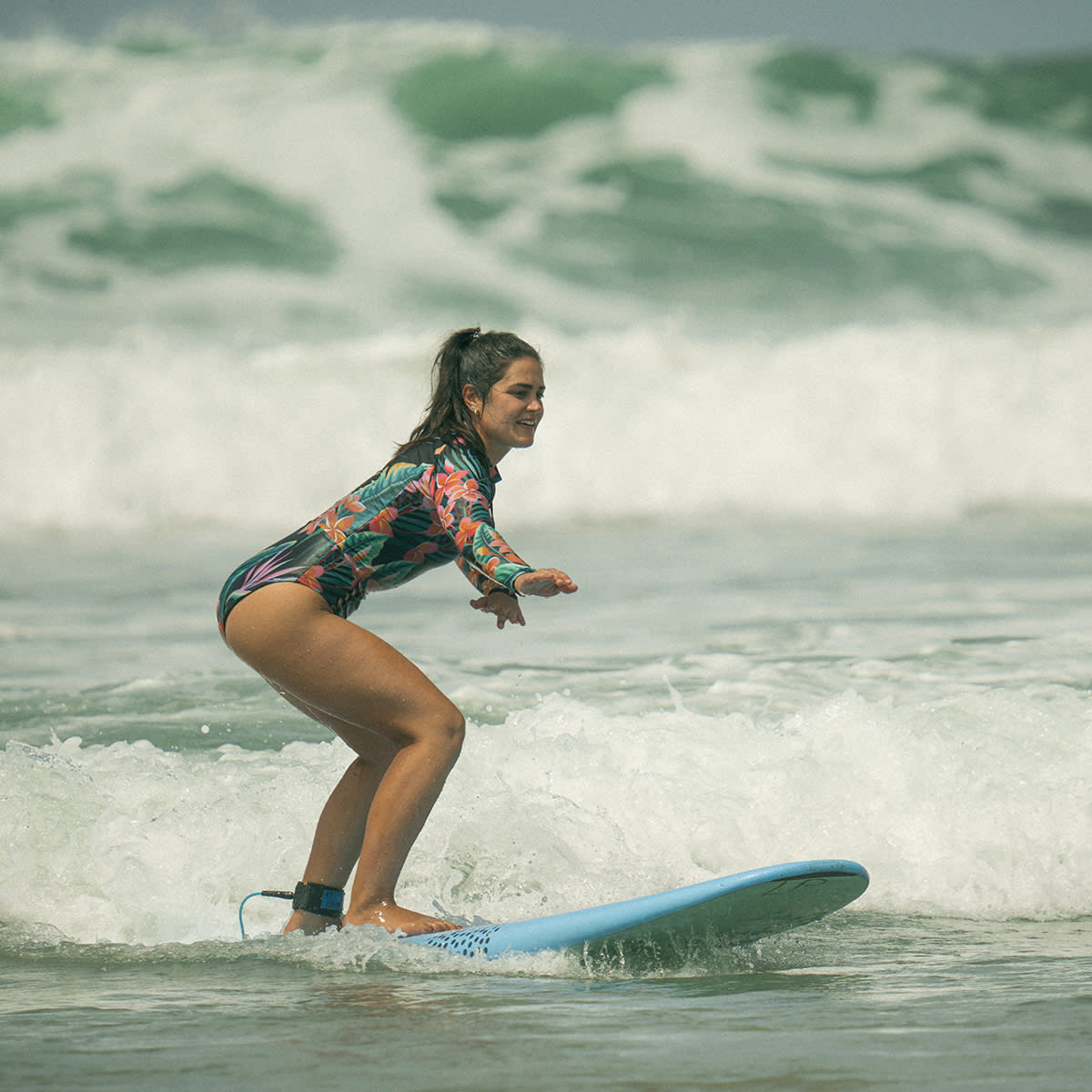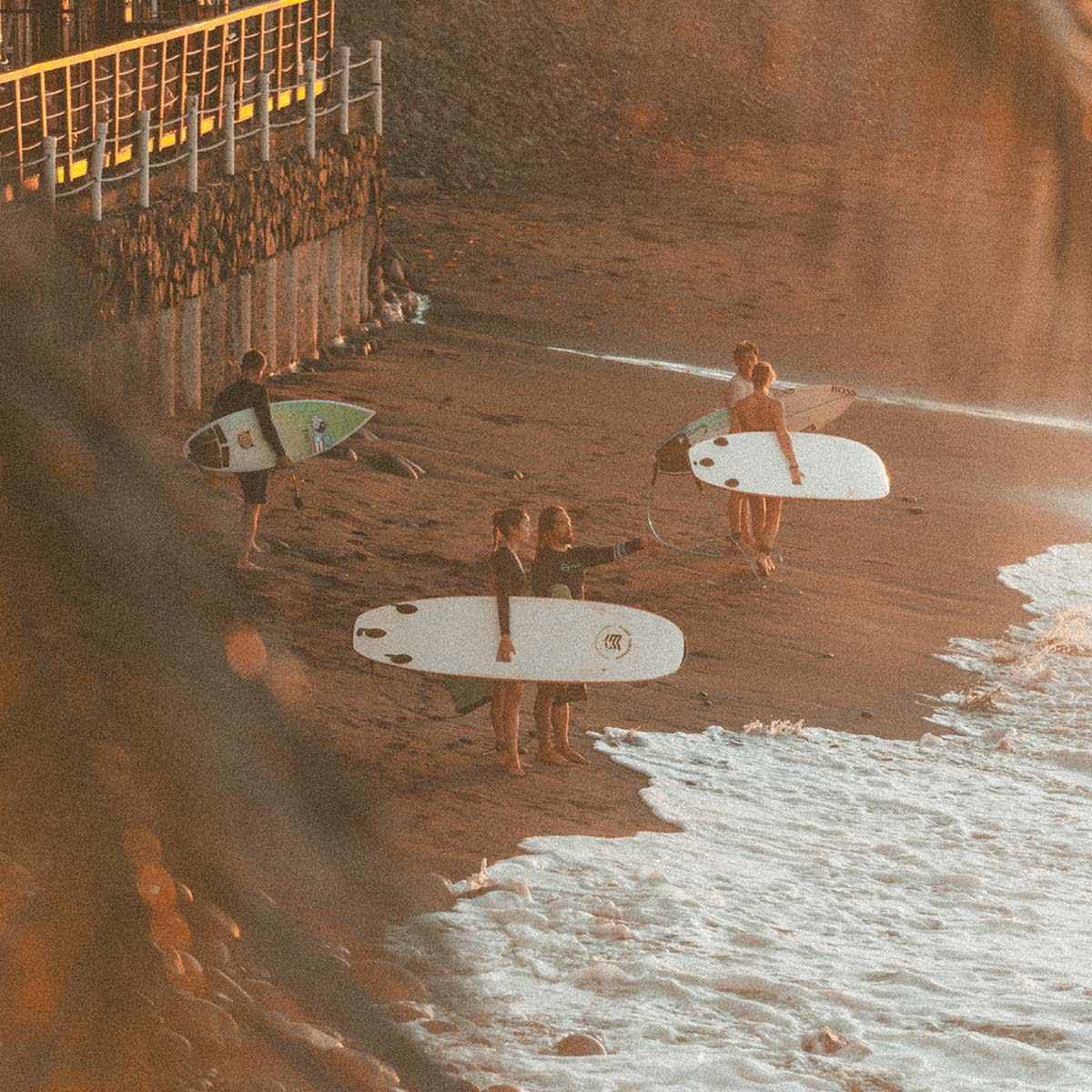
Guide: How to pick the best soft top surfboard for beginners
August 21, 2025Choosing your first surfboard can feel overwhelming, but it doesn’t have to be. If you’re just getting into surfing, a soft top surfboard is one of the best ways to start. In this guide, we’ll share everything you need to know to find the perfect surfboard for beginners – including 9 solid tips to help you pick the right board for your surf journey.
Soft tops are everywhere at surf camps and beaches around the world, and there’s a reason for that. They’re safe, stable, and super forgiving, making them ideal for new surfers. But not all soft top surfboards are the same.
From board size to brands and performance features, it’s worth knowing what to look for before you buy or rent a board. These tips will help you find the best soft top surfboard for beginners.
If you’re looking for a more advanced board, then check out “How to choose the best surfboard: What size surfboard should I get?”.
The soft top surfboard checklist
The 9 things we will walk you through in this guide:
Length: Aim for 8–9 feet for max stability and easy wave catching
Volume: Look for high volume (60–80+ liters) for better float
Width & shape: Go for a wide board with a rounded nose for easier balance
Weight & height: Match the board size to your body size for proper support
Durability: Choose a tough board that can handle dings and wipeouts
Safety features: Soft rails, flexible fins, and cushioned decks are ideal
Wax or no wax: Some soft tops need wax for grip, others don’t
Stick to trusted beginner-friendly brands
Your progression: Will you outgrow it quickly, or is it good for learning and progressing?
Are soft top surfboards good for beginners?

Yes, soft tops are perfect for beginners! They’re made with a foam deck that’s softer and more forgiving than traditional fiberglass surfboards, which means fewer bruises and more fun when you wipe out (which you will!). They’re also great at catching waves early, helping you build confidence quickly.
What kind of surfboard should I get as a beginner?

As a beginner, go for something with:
Plenty of volume (for float and stability)
A rounded nose (for easier paddling)
A length around 8–9 feet
A soft top surfboard construction for safety and comfort
This combo helps you stand up faster, stay balanced, and catch more waves.
What to consider when getting a soft top surfboard
1. Pick the right length: Aim for 8–9 feet
The longer the board, the easier it is to catch waves and stay balanced. For beginners, an 8 to 9-foot board is perfect because it gives you lots of surface area to stand on. It might feel big at first, but that’s a good thing because it’ll help you stand up more easily. Shorter boards are harder to control and not ideal when you're just starting out.
2. Volume: Look for 60–80+ liters
Volume = float. A surfboard with more volume helps you float better and paddle faster, which makes catching waves a lot easier. Beginner boards should have at least 60 liters of volume, more if you’re taller or heavier. You’ll feel more stable and spend less time falling off.
3. Width & shape: Wide boards with round noses
Wider boards give you more balance, and a round nose adds extra stability. That combo is ideal when you’re learning to pop up and ride your first waves. Pointy or narrow boards are designed for advanced surfers and quick turns, not for learning. Stick with something that looks wide and friendly!
4. Weight & height: Match the board to your size

If you're taller or heavier, go for a longer and thicker board to support your weight. A smaller person might do better with a slightly shorter board, but still around 7–8 feet.
The key is making sure the board floats you well and doesn’t sink under you. The better it matches your size, the easier your sessions will be.
5. Durability: You want something tough
Wipeouts and dings are part of learning, so your board needs to be able to take a few hits. Soft tops are great because they’re built with foam that can handle a beating without cracking. Look for one that’s known for being sturdy and long-lasting. That way, you won’t have to replace it after a few surf sessions.
6. Safety features: Soft rails, flexible fins & soft decks
Soft tops are perfect for beginners because they’re way safer than hardboards. Soft edges (called rails), bendy fins, and foam tops mean fewer bruises if you wipe out or get hit by your board. You can focus on learning without worrying too much about injuries. Trust us, your face will thank you.
7. Wax or no wax: Check the grip
Some soft top surfboards come with a built-in grip on the top, so you don’t need to wax them. Others might still be slippery, and you’ll need to add surf wax to keep from sliding off. Before you hit the waves, check if your board feels grippy enough. If not, grab some beginner-friendly wax.
8. Buy from a trusted brand
Go for a brand that sells solid beginner boards and has been around for a while. Buying from a trusted brand means better quality, more safety, and helpful customer support if anything goes wrong. It’s worth it!
9. Your progression: Think short- and long-term
Will this board still work as you get better, or will you need a new one fast? Some soft tops are great for your first few months, while others can grow with you as your skills improve. If you’re super into surfing, it might be worth getting one that lets you progress a bit. But if you’re just starting and unsure, a basic soft top is all you need.
Bonus tips: Don’t fall for “pro surfer” marketing

Boards designed for advanced riders might look cool, but they’ll work against you in the early days. Stick to designs made for learning.
What are the best soft top surfboards?

It depends on your style and budget, but some of the best soft top surfboards for beginners in 2025 include:
Catch Surf Odysea Log: stylish and fun, also great for progression
Softech Roller: super floaty and easy to handle
Wavestorm Classic 8ft: a true beginner icon, affordable and reliable
Olaian 8’ Foam Surfboard 100: great starter board if you're in Europe
Foamies vs. soft-top epoxy boards: What’s the difference?
Foamie (foam board/soft top)
What it is: A surfboard made with a soft foam exterior, including a soft deck, rails, and sometimes flexible plastic fins.
Why it’s great: Very safe, super buoyant, and forgiving. Ideal for total beginners, surf schools, and kids.
Downside: Less responsive and not as durable long-term if used heavily.
Best for: First-time surfers who want a stable, safe board to learn on.
Soft-top epoxy surfboard
What it is: A surfboard with a foam top layer for safety and grip, but an epoxy core and bottom for strength and performance.
Why it’s great: You get the best of both worlds, safety and comfort from the soft top, and durability and responsiveness from the epoxy construction.
Downside: Slightly more expensive, and a bit heavier than full foamies.
Best for: Beginners who want a board that’s safe but also good for progressing in the long term.
Should I get a hardtop or soft top surfboard?

If you’re a beginner, go for a soft top surfboard. They’re easier to learn on and safer if you take a tumble. Hard tops (fiberglass or epoxy) are better for more advanced surfers who want speed, sharp turns, and more performance. You can always level up later!
Armed with these tips, you’re more than ready to choose your first surfboard for beginners. Your soft top will be your best friend in the waves!
Newsletter
Stay up to date!

Beatrice Lindfors
About the author: My name is Beatrice, but Bea for short, and I’ve been a writer and content creator for Lapoint since 2022. My life revolves around my laptop and backpack as I travel the world, always with a stop in Ericeira; the camp vibe and the Portuguese sunsets have my heart.
Life goal? Visit every country.
Obsession? The Sri Lanka waves, the Atlantic Ocean and tracking down the best coffee (whichever my current location is).

